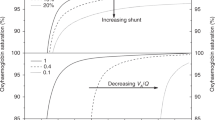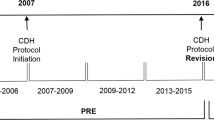Abstract
Objective
Our objective was to investigate the correlation of Oxygen Saturation Index (OSI) with Oxygenation Index (OI) and determine OSImax values that could predict need for ECMO and death in Congenital Diaphragmatic Hernia (CDH).
Study design
This is a retrospective cohort study of infants with CDH admitted to a tertiary level VI NICU. Pearson’s correlation coefficient and simple linear regression analysis were used to investigate the OSI: OI correlation, and logistic regression analysis to investigate OSImax values that predicted need for ECMO and death.
Results
Among the 180 infants, OSImax value of >13 at 6 h of life (HOL) best predicted need for ECMO and death. There was a strong correlation between OSI: OI paired values (r = 0.876, p < 0.001). The linear regression equation was OI = −2.4 + 2.4(OSI).
Conclusion
OSI could be used as a valuable adjunct to OI in the clinical management of newborn infants with CDH.
This is a preview of subscription content, access via your institution
Access options
Subscribe to this journal
Receive 12 print issues and online access
$259.00 per year
only $21.58 per issue
Buy this article
- Purchase on Springer Link
- Instant access to full article PDF
Prices may be subject to local taxes which are calculated during checkout




Similar content being viewed by others
Data availability
All data analyzed for this study have been included in the article. Additional inquiries regarding the data can be directed to the corresponding author.
References
Tovar JA. Congenital diaphragmatic hernia. Orphanet J Rare Dis. 2012;7:1–5.
Gupta VS, Harting MT Congenital diaphragmatic hernia-associated pulmonary hypertension. InSeminars in Perinatology (2020) Feb 1 (Vol. 44, No. 1, 151167). WB Saunders.
Kinsella JP, Steinhorn RH, Mullen MP, Hopper RK, Keller RL, Ivy DD, et al. The left ventricle in congenital diaphragmatic hernia: implications for the management of pulmonary hypertension. J Pediatr. 2018;197:17–22.
Patel N, Massolo AC, Kipfmueller F Congenital diaphragmatic hernia-associated cardiac dysfunction. InSeminars in perinatology (2020) Feb 1 (Vol. 44, No. 1, 151168). WB Saunders.
Akinkuotu AC, Cruz SM, Abbas PI, Lee TC, Welty SE, Olutoye OO, et al. Risk-stratification of severity for infants with CDH: prenatal versus postnatal predictors of outcome. J Pediatr Surg. 2016;51:44–8.
Bruns AS, Lau PE, Dhillon GS, Hagan J, Kailin JA, Mallory GB, et al. Predictive value of oxygenation index for outcomes in left-sided congenital diaphragmatic hernia. J Pediatr Surg. 2018;53:1675–80.
Tan YW, Ali K, Andradi G, Sasidharan L, Greenough A, Davenport M. Prognostic value of the oxygenation index to predict survival and timing of surgery in infants with congenital diaphragmatic hernia. J Pediatr Surg. 2019;54:1567–72.
Tan YW, Adamson L, Forster C, Davies B, Sharkey D. Using serial oxygenation index as an objective predictor of survival for antenatally diagnosed congenital diaphragmatic hernia. J Pediatr Surg. 2012;47:1984–9.
Mileder LP, Buchmayer J, Baik-Schneditz N, Schwaberger B, Höller N, Andersen CC, et al. Non-invasively measured venous oxygen saturation as early marker of impaired oxygen delivery in preterm neonates. Front Pediatr. 2022;10:834045. Jan 28
Maneenil G, Premprat N, Janjindamai W, Dissaneevate S, Phatigomet M, Thatrimontrichai A. Correlation and prediction of oxygen index from oxygen saturation index in neonates with acute respiratory failure. Am J Perinatol. 2021. https://doi.org/10.1055/a-1673-5251.
Khalesi N, Choobdar FA, Khorasani M, Sarvi F, Haghighi Aski B, Khodadost M. Accuracy of oxygen saturation index in determining the severity of respiratory failure among preterm infants with respiratory distress syndrome. J Matern-Fetal Neonatal Med. 2021;34:2334–9.
Muniraman HK, Song AY, Ramanathan R, Fletcher KL, Kibe R, Ding L, et al. Evaluation of oxygen saturation index compared with oxygenation index in neonates with hypoxemic respiratory failure. JAMA Netw open. 2019;2:e191179.
Rawat M, Chandrasekharan PK, Williams A, Gugino S, Koenigsknecht C, Swartz D, et al. Oxygen saturation index and severity of hypoxic respiratory failure. Neonatology. 2015;107:161–6.
DesPrez K, McNeil JB, Wang C, Bastarache JA, Shaver CM, Ware LB. Oxygenation saturation index predicts clinical outcomes in ARDS. Chest. 2017;152:1151–8.
Ruano R, Lazar DA, Cass DL, Zamora IJ, Lee TC, Cassady CI, et al. Fetal lung volume and quantification of liver herniation by magnetic resonance imaging in isolated congenital diaphragmatic hernia. Ultrasound Obstet Gynecol. 2014;43:662–9.
Cohen J. A power primer. Psychol Bull. 1992;112:155–9.
Horn-Oudshoorn EJ, Vermeulen MJ, Crossley KJ, Cochius-den Otter S, Schnater JM, Reiss IK, et al. Oxygen saturation index in neonates with a congenital diaphragmatic hernia: a retrospective cohort study. Neonatology. 2022;119:111–8.
Horn-Oudshoorn EJ, Vermeulen MJ, Knol R, Te Pas AB, Cochius-den Otter SC, Schnater JM, et al. The oxygen saturation index as early predictor of outcomes in congenital diaphragmatic hernia. Neonatology. 2023;120:63–70.
Bickler PE, Feiner JR, Severinghaus JW. Effects of skin pigmentation on pulse oximeter accuracy at low saturation. J Am Soc Anesthesiologists. 2005;102:715–9. Apr 1
Author information
Authors and Affiliations
Contributions
SHG: Conceptualization, Methodology, Investigation and Drafting and editing the initial manuscript. KM: Conceptualization, Investigation and Review of manuscript. AM: Conceptualization and review of manuscript. JLH: Methodology, Formal analysis and review of manuscript. CJF: Supervision, Conceptualization, methodology, formal analysis and review of manuscript.
Corresponding author
Ethics declarations
Competing interests
The authors declare no competing interests.
Additional information
Publisher’s note Springer Nature remains neutral with regard to jurisdictional claims in published maps and institutional affiliations.
Rights and permissions
Springer Nature or its licensor (e.g. a society or other partner) holds exclusive rights to this article under a publishing agreement with the author(s) or other rightsholder(s); author self-archiving of the accepted manuscript version of this article is solely governed by the terms of such publishing agreement and applicable law.
About this article
Cite this article
Hari Gopal, S., Martinek, K.F., Holmes, A. et al. Oxygen saturation index: an adjunct for oxygenation index in congenital diaphragmatic hernia. J Perinatol 44, 354–359 (2024). https://doi.org/10.1038/s41372-023-01845-8
Received:
Revised:
Accepted:
Published:
Issue Date:
DOI: https://doi.org/10.1038/s41372-023-01845-8



